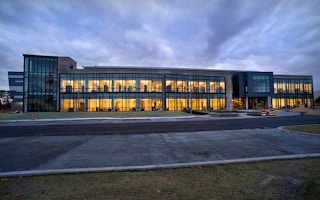Improving the energy efficiency of buildings lacks the glamour of headline-grabbing urban innovations such as drone-based delivery and elevated bicycle highways.
Yet for cities determined to achieve sustainable growth, it’s a must. Buildings account for about one-third of all greenhouse gas emissions and it’s more like half in many big cities.
Reducing the energy used to heat, cool and light buildings has to be an essential ingredient of any municipality’s broader climate goals.
A pair of reports released last month contain recommendations and case studies aimed at helping city leaders craft policies for the buildings sector.
The first, from the World Resources Institute (WRI), highlights strategies that local governments can employ to maximise efficiency in buildings.
Accelerating Building Efficiency - 8 Actions for Urban Leaders, emphasises that decisions made today on how to construct, design and operate buildings will have lasting consequences owing to the long lifespan of buildings.
Here are the eight approaches cited in the report that cities can implement:
- Building codes and standards: Uniform requirements for new and existing structures would at least ensure a “minimum level of energy efficiency”, the report says. They should cover design, construction and operation. The upside for building owners is that such codes promote long-term savings.
- Energy-efficiency targets: Municipalities can set mandatory energy-reduction goals for city-administered buildings and voluntary benchmarks that apply to all other structures.
- Measure and track performance: Audits, certification programs and disclosure requirements are among the tools cities can use to measure the energy performance of buildings. The data can help building owners, managers and occupants make smarter energy use and administrative decisions.
- Financial incentives: Grants, rebates, bonds, mortgage financing, loans, credit lines and tax incentives are some approaches cities can introduce to help projects overcome economic hurdles. These funding mechanisms are particularly useful for initiatives with steep upfront expenses.
- Lead by example: Municipal governments can initiate policies and projects that set an example for the community and foster greater acceptance and demand for energy-efficiency solutions. Cities can start with government-owned buildings or pursue pilots with the private sector.
- Engagement strategies: Competitions, awards and kiosks that facilitate occupant feedback are ways to spur dialogue among tenants, building owners and management.
- Technical training: Educational programs allow stakeholders to develop the skills needed to implement the latest energy conservation designs. Another technical area involves financing. Improved engagement with the financial sector can result in standardized investment terms and reductions in transaction costs, the report says.
- Partner with utilities: Municipalities can widen their access to energy usage data through alliances with local utilities. The information can help city planners make smarter decisions about energy efficiency goals.
The recommendations are intended to help city leaders avoid costly mistakes that could “lock-in” bad decisions about the built environment for decades.
“Policies can enable the market to overcome barriers to energy efficiency at each stage in the lifecycle of any type of building,” the report says.
Seven innovative cities
The second report, from the C40 Cities Climate Leadership Group, is titled Urban Efficiency II: Seven Innovative City Programmes for Existing Building Energy Efficiency.
It is intended to serve as a resource for city leaders and decision makers in designing programs that promote energy efficiency in buildings. The cities profiled in the report are in North America, Europe and Asia.
Shenzhen is praised for its “International Low-Carbon City” initiative in Pingdi, a formerly poor and undeveloped district. The new urban enclave features ambitious environmental and economic targets for 2025.
“This is unique among the sampled programmes in many respects,” the authors state. All development in the eco-city is part of a carefully crafted master plan.
Businesses and industries are vetted for their “strategic importance” to the community.
Decisions on construction, retrofits and expansion hinge on whether an entity would add value, such as through reliance on renewable energy or minimal production of waste and emissions.
Among the other highlights from the C40 report:
- Mexico City and Tokyo have implemented sustainable building certification programmes that aim to make data about energy usage more transparent. “Carbon report cards” about individual building performance versus industry benchmarks help tenants gauge usage and costs.
- Seoul offers low-interest loans with “generous” repayment and grace periods to help building owners afford retrofits. The city financed more than 4,000 residential and commercial energy efficiency upgrades from 2012 to 2015.
- The Retrofit Chicago Energy Challenge supports voluntary energy efficiency steps by commercial, institutional and private buildings. It aims to help participants reduce energy consumption by 20 percent over five years.
- In Boston, a public-private partnership called the Renew Boston Trust directs private investor funds into energy projects in commercial properties.
- London’s Business Energy Challenge is a voluntary initiative that gives the private sector a lead role in helping businesses wean themselves from fossil fuels. The focus is on reducing emissions that contribute to climate change, with the most successful businesses receiving mayoral recognition and awards.
C40 sees value in multi-faceted energy reduction initiatives that integrate several governance priorities into single programs—or “cross-link” related efforts.
Tokyo has adopted this model by requiring participating facilities to measure and submit energy consumption and emissions data and make performance ratings publicly available.
Mexico City’s Sustainable Buildings Certification Programme is even more comprehensive. Owners and tenants are required to take actions that address everything from energy, water and waste to transport and social and environmental responsibility,
“City policymakers are able to mandate or encourage multiple forms of action or engagement from building owners and tenant” with this approach, the report says.
This story was published with permission from Citiscope, a nonprofit news outlet that covers innovations in cities around the world. More at Citiscope.org.

















